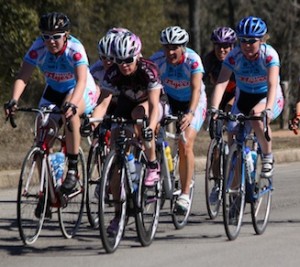Every woman’s guide to bunch riding
 Earlier this year my cycling club LACC started a women’s only bunch ride which I was asked to lead. It started out as part of a pilot program for women’s bunch rides under the auspices of Cycling NSW, and when the pilot program concluded at the end of March, the regular participants voted to keep going with the weekly ride.
Earlier this year my cycling club LACC started a women’s only bunch ride which I was asked to lead. It started out as part of a pilot program for women’s bunch rides under the auspices of Cycling NSW, and when the pilot program concluded at the end of March, the regular participants voted to keep going with the weekly ride.
I was very happy to continue with it and get real buzz out of encouraging other women to learn more about road cycling and riding in a group.
It’s a straightforward ride, just four short laps around Sydney Olympic Park, a total of about 25 km, followed by a mandatory café visit and we all head home around 7 am. If you’d like to know more about it visit the LACC Women’s Facebook page.
Today I was enjoying reading through the latest articles on one of my favourite online cycling sites Ella Cycling tips when I came across these great posts from pro cycling Verita Stewart. They are entitled Don’t be that cyclist and Do be this cyclist and I would recommend a read. They reminded me of the some of the etiquette of bunch riding so here’s a few tips from me on joining a group bunch ride:
Communicate
One of the great benefits of riding in a group is that you’ve got a collective of people all with two eyes keeping a look out for obstacles, issues and each other. So in the groups I ride with we let each other know if there’s an issue affecting our safety. This includes calling ‘clear’ or ‘car right or left’ at roundabouts and intersections, calling ‘pothole’ or other significant obstacle for the benefit or riders behind, called ‘car back’ if there’s a car passing the group, and signalling an intention to stop at lights, stops signs, etc.
That doesn’t mean you should ride down the road calling out every little twig. I work on the principle that you should call significant issues and just point to lesser ones. Some more experienced riders prefer to use hand signals exclusively, but I think particularly for less experienced riders it is worthwhile to use some calls.
Take a turn at the front
Some group rides are just a group of friends out for a ride and it is likely that in this situation the stronger riders spend the majority of time on the front. There are also more formal bunch rides where each rider will have their turn at the front. So make your own judgement about whether you need to spend much time on the front. If you are weaker than the majority of riders then you’ll be better off having a brief time on the front of the group.
Give it a go
Don’t be intimidated by fast looking bunches. Find one that suits your pace, or preferably that goes just a little faster than you would normally, so you can challenge yourself. My Wednesday ride goes at a moderate pace and has a no drop policy which means that we will never leave anyone behind. If you’re planning to join a bunch ride it’s worth checking what average speed they usually travel at and whether they wait for people.
Listen to other people’s advice
Learn from others who are more experienced than you. There is a lot to learn from the people in your cycling community so take the time to listen and learn. Don’t be afraid to ask questions and challenge their suggestions if they don’t make sense. We all start somewhere!
Head up
It is also important to keep your head up when you are riding closely behind another rider. Don’t stare at the actual wheel but rather look through them at hip level so that you can see if there’s an issue ahead of you.
Don’t overlap wheels
Another important skill to master is to follow the line of the rider in front so you are not ‘overlapping’ their wheel. It’s alright to ride off-centre from them a little, but don’t let your front wheel overlap their back wheel and come up beside them, because if they move across they’ll bump your front wheel with their rear wheel and send you packing.
Be consistent
When you are following closely behind someone you need to ride at the same speed as them and remain consistent because you are likely to have another rider on your wheel. If you have to brake for some reason then tell the rider behind what you are doing.
Leading another rider safely and smoothly also requires practice and is not that easy to do well. With someone riding closely behind, you have a responsibility to keep them safe too, which means no sudden braking, or change of direction that might cause them to touch your wheel. There’s no compliment higher for me than another rider telling me that they like riding on my wheel because I ride at a consistent pace.
